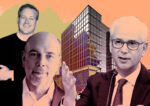Trending
Plenty of beds ahead
City to hit record 110,000 rooms by 2016; insiders say that’s no glut, but could hold back nightly rates

Hotel developers are making 110,000 bets that tourists and business travelers will continue streaming into New York City in record numbers in the coming years.
Despite the cyclical nature of the hospitality business, and the fact that there are already an unprecedented number of places for tourists to lay their heads in the five boroughs, the hotel construction boom will deliver roughly 11,000 new rooms in the next three years, bringing the total to 110,000 by 2016, a number not seen in living memory.
Right now, hospitality sector analysts expect room rates to continue to rise — albeit at a more modest pace than in recent years — and for the city to continue outperforming the rest of the nation in terms of occupancy, even as more beds become available.
In other words, there’s no glut. At least not yet.
But the pace of new hotel development in New York City, combined with the inevitably of future downturns, suggests the real possibility of oversupply on the horizon. As one analyst reminded The Real Deal, the industry can turn on a dime.
Coming into 2014, the city’s hotel inventory stood at an all-time high of about 99,000 rooms. That was up by nearly 30 percent from 76,400 six years ago, at the start of the recession, and a gain of about 6.5 percent from the beginning of 2013, according to NYC & Co., the city’s tourism arm.
From January 2011 through October 2013, 59 new hotels opened in the five boroughs, according to NYC & Co., with 39 of them in Manhattan.
These include the giant 487-room, full-service Hyatt Times Square; the 240-room Viceroy on West 57th Street; the Jade, with its 113 rooms on West 13th Street, and chains like the 90-room Fairfield Inn Chinatown.
And that’s just the start.
An additional 84 hotels are expected to open between now and 2016. Most of those are also in Manhattan, but there will be 10 in Queens, nine in Brooklyn, three in Staten Island and one in the Bronx.
These hotels also run the lodging gamut. They include the 330-room Bossert Hotel conversion in Brooklyn Heights; the renovation of the old Knickerbocker Hotel near Times Square into a 300-room full-service inn; a new 243-room Residence Inn by Marriott across from the new World Trade Center; and the ultraluxury Baccarat Hotel & Residences across from the Museum of Modern Art, which will have 114 rooms and 26 suites.
The frenetic development of hotels in New York springs from one main factor: a steady torrent of travelers.
The city saw approximately 54.3 million tourists in 2013, shattering 2012’s record of 52 million, and a 54 percent increase over 2002, the year after the September 11 terrorist attacks.
In December, city officials predicted that the number of tourists would hit 55 million in 2014. That, of course, is good news for the hotel industry.
“A lot of these projects are predicated on the current strong market conditions,” said Tom Baker, managing director of the hospitality sector at commercial firm Savills US. “And their financing is based on that, and their projections are based on that. New York City has outperformed every market in America, and I think it’s going to continue to be the strongest market in America.”
Unless, of course, there is another sharp economic downturn.
Filling rooms
 The city ended 2013 with a hotel occupancy rate of nearly 87 percent, according to Sean Hennessey, the founder and CEO of hotel consultancy Lodging Advisers LLC. That compared with the recession low of 80.2 percent in 2009.
The city ended 2013 with a hotel occupancy rate of nearly 87 percent, according to Sean Hennessey, the founder and CEO of hotel consultancy Lodging Advisers LLC. That compared with the recession low of 80.2 percent in 2009.
Hennessey predicted that the hotel occupancy rate would remain around 87 percent this year, even as large hotels like the Knickerbocker open.
He also forecasts that room rates would continue to rise, but said the increased supply will probably temper those gains.
“The pace of opening new hotels is definitely dampening or holding back the pace of improvement in average room rates that we’ve seen in this cyclical recovery, compared to prior cycles,” Hennessey said.
During the last few economic recoveries, the city’s average daily room rate increased annually between 8 and 12 percent. But while rates spiked 8.2 percent in 2010 off 2009’s recession low, the pace of gains has slowed sharply since then, rising between 2.6 and 5.6 percent in the last three years, Hennessey’s data show.
In 2013, it was up an estimated 4.5 percent. For 2014, Hennessey sees the average daily rate increasing 5.6 percent to $306 — basically matching the peak pre-recession rate in 2008.
Yet even as rate increases moderate, the new development should not impact the pace of growth for hotels’ bottom lines, according to Hennessey’s analysis, which included data from Smith Travel Research.
In 2008, as the recession started, the revenue per available room (or RevPAR) for Manhattan hotels was $257. It dropped below $200 in 2009. In 2014, it’s expected to reach a post-recession high of $264.91.
Other factors, too, bode well for the hotel sector, sources say.
The city’s economy has recovered faster than the rest of the nation’s. Major office development is also continuing apace, with tens of millions of square feet due to come online at projects like the World Trade Center and Hudson Yards. Such office space presupposes business travelers coming into town for meetings.
“The Hudson Yards is slated to include two or three significant hotel aspects,” Baker said. “Those will get built, because the office space is being built to support them.”
Still, the city’s hotel market, however strong, is volatile. Economic shifts, spurred by any number of factors, can quickly translate into fewer travelers and softening of the hospitality sector.
“A lot of people look at hotels as sort of the more risky asset classes,” said Matthew Baron, a principal at Simon Development, which is building a still-unnamed 33-story, 250-room hotel at 31st Street and Madison Avenue. He said he’s largely confident in the market in the next couple of years — his firm’s hotel is due to open toward the end of 2015.
But the recent past offers a cautionary tale: Between 2008, when the recession struck, and 2009, Manhattan’s average daily room rate plummeted more than 26 percent, according to Hennessey. And RevPAR saw a similar drop.
“When you compare multi-family with a hotel,” Baron said, “ you have to rent that room every night. God forbid, if there’s an economic collapse like in 2008, your room rates can go from $300 to $150 literally overnight.”
Leading locations
Some locations in the city will undoubtedly see more hotel development and activity than others, along with sharper increases in key metrics.
Of the 28 Manhattan hotels projected to open this year, nine are in Midtown or Midtown South, or close by, such as the 135-room Cambria Suites Chelsea, being built on West 28th Street by a partnership led by Choice Hotels International.
Another nine are below 14th Street, including the 162-room Hotel Ludlow on the Lower East Side and the as-yet-unnamed 90-room inn at 24 John Street in the Financial District, which are being developed by BD Hotels, the team behind the Bowery Hotel and the Jane.
Average room rates are expected to increase the most in 2014 on the East Side and Uptown, by about $15 a night from 2013, according to Hennessey. Times Square and points farther south, meanwhile, will likely see more modest room rate growth of $5 to $10 a night.
In Brooklyn, new hotels are slated to open or are planned for Brooklyn Heights, the BAM Arts District, Dumbo, Williamsburg and the area around the Barclays Center. In Queens, the hotel development is mostly centered in Jamaica, Flushing and Long Island City.
Hennessey forecasts average Brooklyn rates will rise as high as $195 in 2014, up $10 from last year. Occupancy rates will hover around 85 percent, up from 80.7 percent in 2012.
“The reason for that is Brooklyn has increased its attractiveness as a destination,” he said, “There is a segment of the traveling public who prefers to be in Brooklyn.”
There’s also a segment, of course, that prefers luxury — and the luxury end of the New York hotel market should have another strong year. Though suites at some of the city’s highest-end hotels go for mid-four figures a night, the average nightly cost of a luxury Manhattan hotel room is expected to increase to as high as $440 in 2014, up $20 from last year, according to Hennessey.
Economy inns and most chain hotels will see softer rate increases, though occupancy rates for these sectors will be uniformly higher and could even exceed 90 percent. The reason for that goes back to development as well: Construction of mid-scale hotels, especially chains, outpaced luxury hotel development over the last few years.
“Overall,” Hennessey said, “the addition of all these new hotels is making hoteliers more focused on cutting room rates or keeping them low, to make sure they get their fair share of customers.”





